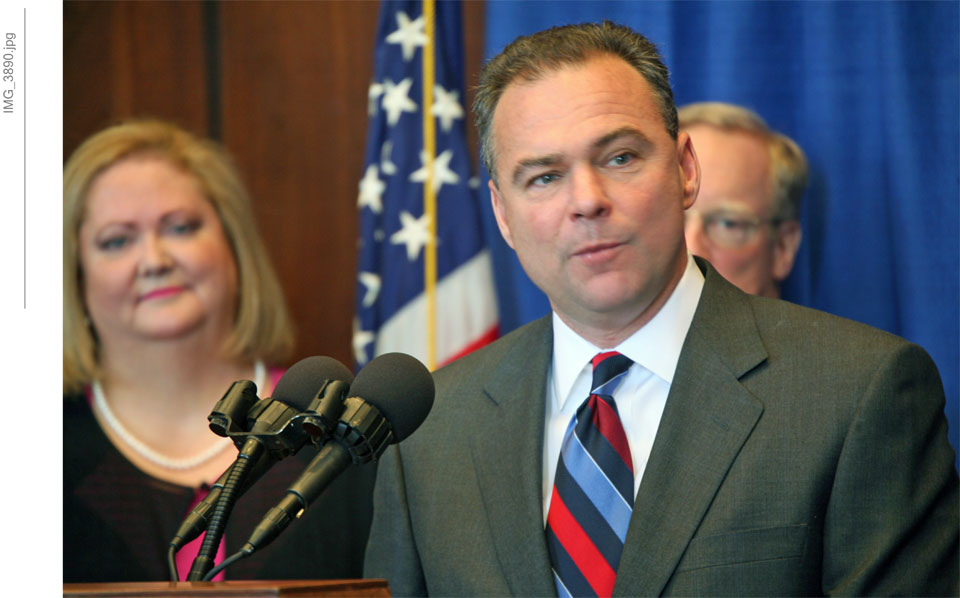This is the sixth in a series of posts spotlighting recently released email from Governor Tim Kaine’s administration. These posts are not meant to be comprehensive but to encourage further exploration in the Kaine administration records (electronic and paper).
The Washington Metropolitan Area Transit Authority announced on 23 June 2014 that the first phase of Metro’s Silver Line – 11.4 miles of track beginning in East Falls Church station, through Tysons Corner, and ending at Wiehle Avenue in Reston – will begin service on 26 July 2014. When finished the 23-mile Dulles Corridor Metro Project will provide service to Dulles International Airport.
Photograph of Governor Tim Kaine, announcing the signing of the MOU between the Commonwealth and Metropolitan Washington Airports Authority
27 March 2006. `{`no title`}`, 2006-03-27 08:58, Inbox.pst (Winchell, Robin), Email Records from the Office of the Governor (Kaine: 2006-2010), Library of Virginia, Richmond, VA.
The Tysons Corner portion of the project – to build a tunnel or an elevated track – was an ongoing issue for the Kaine administration in 2006.
Photograph of United States Senator John Warner with Governor Tim Kaine, announcing the signing of the MOU between the Commonwealth and Metropolitan Washington Airports Authority
27 March 2006. `{`no title`}`, 2006-03-27 08:58, Inbox.pst (Winchell, Robin), Email Records from the Office of the Governor (Kaine: 2006-2010), Library of Virginia, Richmond, VA.
On 24 March 2006, the Commonwealth and the Metropolitan Washington Airports Authority (MWAA) signed a memorandum of understanding to transfer the Dulles Toll Road and control of the Dulles Corridor Metrorail Project to the MWAA. The agreement, announced by Governor Kaine three days later, guaranteed the completion of the entire Metrorail extension to Dulles International Airport, enabled the project to be completed sooner than otherwise possible, and guaranteed all toll revenue would be dedicated to transportation improvements in the corridor.
The day before the signing of the Virginia/MWAA agreement, Dulles Transit Partners, the design-build contractor for phase one, rejected a plan that would have run the Silver Line tracks through a tunnel in Tysons Corner. The contractors estimated that the tunnel approach would cost over $500 million more than a mostly aboveground route. Tunnel supporters argued that the tunnel construction would be less disruptive and in the long run help turn Tysons Corner into a pedestrian-friendly urban downtown. At the urging of the Fairfax County Board of Supervisors, the Kaine administration weighed in. On 15 May, Secretary of Transportation Pierce Homer announced the creation of the Dulles Metrorail Tunnel Review Panel. The independent panel led by the American Society of Engineers (ASCE) was tasked “to conduct an independent evaluation of tunnel and aerial structure alternatives for the proposed Metrorail extension to the Dulles Airport.”
The Tunnel Review Panel issued their final report on 31 July. While the panel was not charged with making any recommendations, their report made clear that the tunnel was a viable option. The panel estimated that the tunnel plan would cost $250 million more than the aerial option. However, the expected life span of the tunnel would be 120 years versus 60 years for the aerial structure. Annual operating and maintenance costs for the tunnel would be $5 million less than the aerial route.
At the request of Governor Kaine, the panel briefed the Northern Virginia congressional delegation and Federal Transit Authority and the panel’s report was discussed with the state, local, and federal partners in this project. “A general consensus emerged from those discussions,” Kaine wrote in an 8 December 2006 email chronicling his administration’s actions. “I believed that, if money were no object, the tunnel route through Tysons was preferable. The Fairfax Board and congressional delegation shared that opinion.” It appeared that the tunnel plan would be approved. The administration even drafted a press release to that effect.
After meeting with the Federal Transit Agency (FTA) and Northern Virginia’s congressional delegation on 6 September, Kaine reluctantly announced that the tunnel option was dead. What changed? Changing from an aerial to tunnel plan would delay the project and put the $900 million federal government financing and the project in jeopardy. “The good news is that this critical project is moving ahead with the unanimous bi-partisan support of the congressional delegation and our local partners,” Governor Kaine said following the meeting. “We carefully reviewed the tunnel option at Tysons, and I share the belief of many of our project partners that a tunnel alignment would be the best option. However, too many unanswered questions remain about the cost and timing. These uncertainties cannot be allowed to jeopardize this critical project.”
Kaine’s decision did not stop proponents of the tunnel. The group “TysonsTunnel.org” held several town hall meetings in the Dulles corridor urging residents to pressure state and federal officials to reconsider the tunnel option. An exasperated Secretary Homer emailed Governor Kaine’s Chief of Staff Bill Leighty on 8 December, that “our problem is that advocates [for the tunnel] simply will not accept any degree of finality to any decision.” The second guessing led Kaine to draft a statement explaining his administration’s actions regarding the tunnel.
The Library of Virginia’s Kaine Email Project makes the email records from the administration of Governor Timothy M. Kaine, Virginia’s 70th governor (2006–2010), accessible online. Users can search and view email records from the Governor’s Office and his cabinet secretaries; learn about other public records from the Kaine Administration; go behind the scenes to see how the Library of Virginia made the email records available; and read what others are saying about the collection. Previous posts spotlighted personal stories, transportation, the state budget and the Kaine records officers. This project would not have been possible without funding provided by Congress for the Library Services and Technology Act (LSTA).
-Roger Christman, LVA Senior State Records Archivist















































